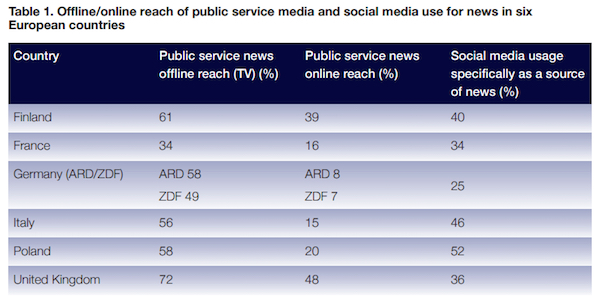The BBC reaches 68 percent of 18- to 24-year-olds in the U.K., both online and offline, in a given week. The German public media organization ZDF, meanwhile, reaches just 24 percent of that age group.
Why is the BBC reaching so many more young people than ZDF? A new report from the Reuters Institute for the Study of Journalism examines how public media can stay competitive online “in a fast-evolving global digital landscape.” The report looks at leading public media organizations in the United Kingdom, France, Germany, Italy, Finland, and Poland.
The researchers found that public media organizations are flourishing online in the U.K. and Finland, but struggling in the other four countries, where “significantly more people get news online from social media than public service media.”

In all of the countries except Poland, about a quarter or more of survey respondents use their smartphones as their main way of accessing online news. (In Poland, smartphones play a more limited role, with 14 percent of respondents using them as their main way of accessing news online.) In the U.K., “half of smartphone users also said they use the BBC news app.”
Here are a few things that the BBC and Finland’s Yle are doing well, according to the researchers:
— “In Finland and the U.K., public service newsrooms have been integrated [across offline and online platforms] for years.” At Yle, for instance, journalists “are asked to think more about the angle and presentation of each story and only then to decide on the appropriate media or platform.”
— Both “stand out for having invested significant resources in building teams tasked with innovation in news production and distribution” — see, for instance, the BBC News Labs, which launched in 2012 and now employ about 20 people:
— The BBC plans to launch BBC Newstream, “a mobile-focused product with a greater focus on video, complemented by audio, graphics, and text live from BBC News [that] aims to integrate personal, portable, and on-demand news.” Yle launches its news app NewsWatch in 2014, and is now redesigning its responsive news site “that was among the first of its kind worldwide when launched in 2012.”Current projects include one on ‘Atomized News,’ to explore a mobile-focused approach to news, one on ‘Structured Journalism,’ on how to empower journalists with better ways of working with information, beyond the headline and text of an article, or one called ‘The Juicer’ that takes news content, automatically tags it, then provides a fully featured API in order to allow the content and data to be accessed.
“The British BBC and the Finnish Yle both reach large audiences with their online news and both have continually carried out substantial organizational reforms to adapt to an environment that continues to change quickly,” the authors write. “The remaining public service media organizations have more limited reach with their online news and their organizations continue to be largely structured around traditional broadcast platforms.”
This is the first in a series of annual Reuters Institute reports that will look at how European public media companies are adapting to digital change. You can read the full report here.
Leave a comment